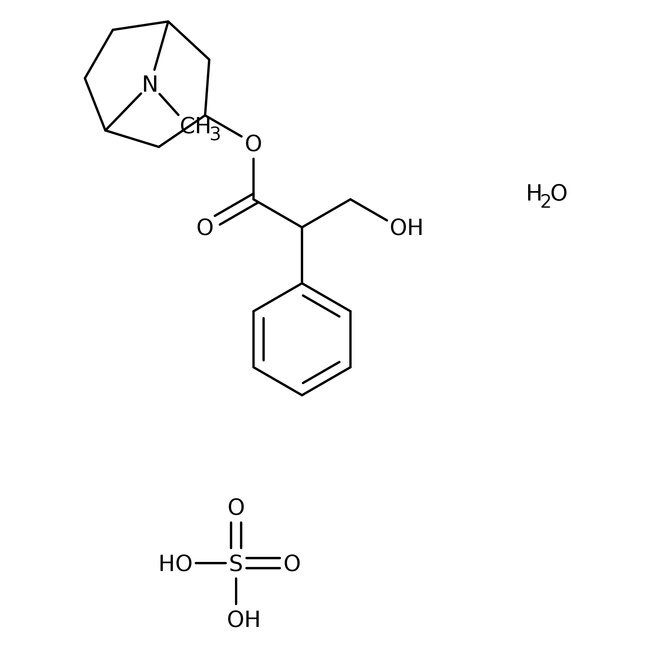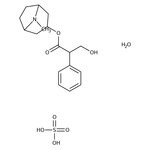Search Thermo Fisher Scientific
Thermo Scientific Chemicals
Atropine sulfate monohydrate, 97+%, Thermo Scientific Chemicals
Catalog number: 226680250
25 g, Glass bottle, Each



Thermo Scientific Chemicals
Atropine sulfate monohydrate, 97+%, Thermo Scientific Chemicals
Catalog number: 226680250
25 g, Glass bottle, Each
Quantity
Packaging
Catalog number: 226680250
Price (EUR)
78,66 Online price
87,40
Each
Quantity
-
Chemical Identifiers
CAS
5908-99-6
IUPAC Name
8-methyl-8-azabicyclo[3.2.1]octan-3-yl 3-hydroxy-2-phenylpropanoate sulfuric acid hydrate
Molecular Formula
C17H27NO8S
InChI Key
PVGPXGKNDGTPTD-UHFFFAOYNA-N
SMILES
O.OS(O)(=O)=O.CN1C2CCC1CC(C2)OC(=O)C(CO)C1=CC=CC=C1
Specifications
Infrared spectrum
Conforms
Water
2.0 to 4.0 % (K.F.)
Specific optical rotation
(25°C, 589 nm) (c=10, water) -0.50° to +0.05°
Appearance (Color)
White
Titration with HClO4
97.0 to 103.0 % (On anhydrous basis)
Description
This Thermo Scientific Chemicals brand product was originally part of the Acros Organics product portfolio. Some documentation and label information may refer to the legacy brand. The original Acros Organics product / item code or SKU reference has not changed as a part of the brand transition to Thermo Scientific Chemicals.
General Description
Atropine is a competitive and reversible antagonist of muscarinic acetylcholine receptors on both central and peripheral neurons
Atropine was originally isolated from the belladonna plant Atropa belladonna but is also found in other Solanaceae plants
Atropine is a drug that can be used to slow heart rate, decrease salivary secretions, and treat poisoning caused by cholinergic or muscarinic agents
Applications
It is used to block activation of muscarinic receptors in laboratory mice
It can be used in a laboratory setting to decrease oral and airway secretions in research animals
Atropine has been used to study heart rate and blood pressure variability in swine
RUO – Research Use Only
Figures
Documents & Downloads
Certificates
Search by lot number or partial lot number
Frequently asked questions (FAQs)
Citations & References
Search citations by name, author, journal title or abstract text
Safety and Handling
Classification of the substance or mixture
CLP classification - Regulation(EC) No 1272/2008
Acute oral toxicity
Category 2
Acute Inhalation Toxicity - Dusts and Mists
Category 2
Label Elements
Signal Word
Danger
Hazard Statements
H300 + H330 - Fatal if swallowed or if inhaled
EU Specific Hazard Statements
May form combustible dust concentrations in air
Precautionary Statements
P260 - Do not breathe dust/fume/gas/mist/vapors/spray
P264 - Wash face, hands and any exposed skin thoroughly after handling
P301 + P330 + P331 - IF SWALLOWED: rinse mouth. Do NOT induce vomiting
P304 + P340 - IF INHALED: Remove person to fresh air and keep comfortable for breathing
P310 - Immediately call a POISON CENTER or doctor/physician
P405 - Store locked up